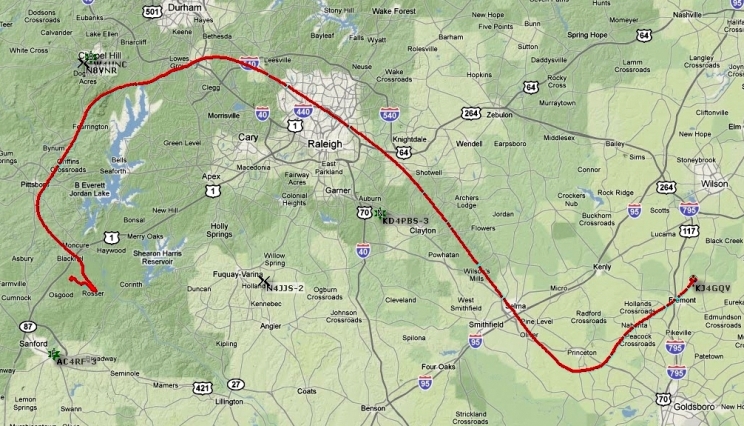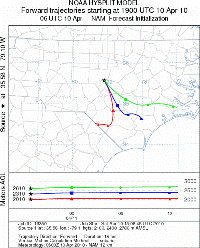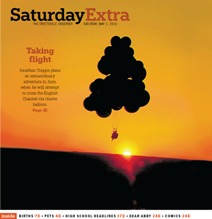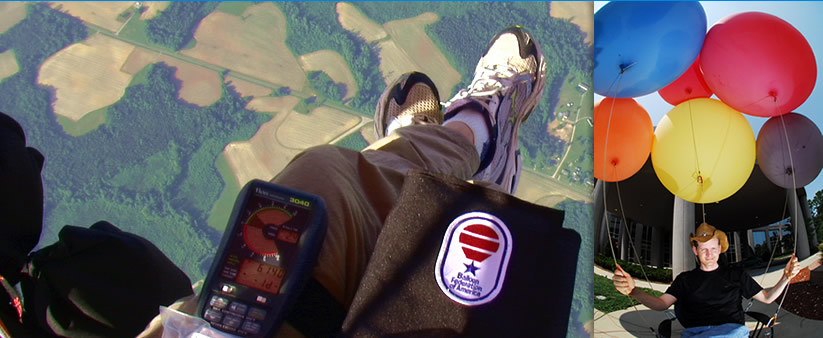The Spirit of Aviation is Alive! Overnight Cluster Balloon flight April 10-11 2010:
"The Spirit Cluster"
 Guinness World Record - Longest Cluster Balloon flight! Survived the night!
Guinness World Record - Longest Cluster Balloon flight! Survived the night!
On April 10th, 2010 we attempted a flight that had never been completed successfully. Since 1937, when the first cluster balloonist went into the skies, no one has ever launched in the daylight and remained aloft all night, greeting the dawn from the skies the following morning.
Our launch window was near the spring equinox, so we would have a rather long night in front of us: over 11 hours. There were some legitimate concerns: we were launching in North Carolina; could we stay aloft all night, and yet stay inland of the coast of the Atlantic Ocean? Winds aloft at mid-levels took us straight to a restricted military airspace at Pope Air Force Base, where they were doing live firings. Would we be able to steer clear of that airspace? Overnight temperatures on the surface would be in the 40's; how would the balloons (and the pilot) react to the low temperatures aloft?
I was thinking of these factors, and many more, as I weighed the decision to float under a cluster of balloons into the quiet night.
Together, as a team, we achieved success. I watched the sun set, traversed 109 miles over my home state, and welcomed the sun upon its return the following dawn. After nearly 14 hours in the silent skies, I returned to earth. The below account tells of the success achieved in this unique form of flight from April 10th through 11th, 2010.
Preparations, and Concerns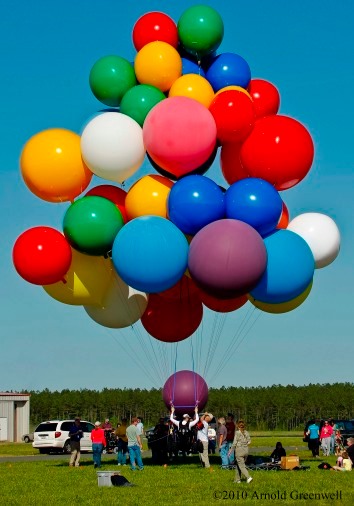
We made the decision to stand the cluster balloon system during the middle of the day. As any balloonist will tell you, this is a terrible idea. There is thermal activity mid-day that will pick up a balloon, whirl it around, and push it back down against the ground very hard-- all of which makes for a rather uncomfortable inflation.
We did have our reasons. Our launch site was within easy range of the Atlantic ocean, and we didn't want to go in the drink. Surface winds were forecast to be calm, but in the early part of the day winds aloft were forecast to send us right out to sea. So the plan would have us inflate mid day, when thermal activity is high, in order to launch once winds aloft had fallen off. Thus the mid-day inflation!
Another concern was the military area directly to our south. Mid-altitude winds were forecast to head directly towards Pope Air Force Base, and the restricted area known as R5311. I contacted Washington Center, the controlling authority for this airspace, and got their military liaison desk. I found that they would be doing live firings in that airspace the day of our flight! Not a good time to float through.
They would never intentionally shoot down a civilian aircraft. But, if there are jets and bombers zooming around, dropping things and shooting, it just would not be a friendly day for us to visit! You can see the restricted area just to the west of Pope Air Force Base.
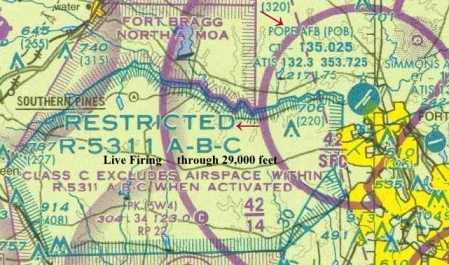 The trajectories for low-level flight, 1,000 to 2,000 feet, had us heading to the north west. This would be good; it is away from the coast and the restricted area! Except, we can't really fly that low, especially in the night. There are large towers and obstructions that would eat a balloon! We need to be higher.
The trajectories for low-level flight, 1,000 to 2,000 feet, had us heading to the north west. This would be good; it is away from the coast and the restricted area! Except, we can't really fly that low, especially in the night. There are large towers and obstructions that would eat a balloon! We need to be higher.
The next set of trajectories had us heading south, towards the restricted area. Not so good. Then the high-level trajectories had us heading to the coast, too fast to survive the night. We'd make it to the water before dawn.
So, I would have to use a combination of these altitudes to steer away from the verboten areas, avoid the towers, stay high enough above the cities, and remain over dry land through the night. Click for full trajectories, with the verboten areas marked:
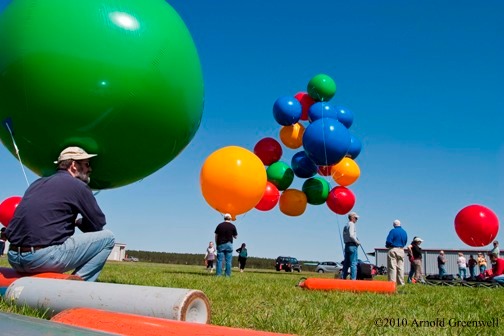 Inflation - Leaning Tower
Inflation - Leaning Tower
The winds were 'calm'-- if you ignored the thermals that blew through! We had an outstanding group of people help stand this cluster, and a number of them were left holding full balloons, waiting to add them to the system as the thermal activity leaned the partially assembled cluster like the tower of Pisa. If the tower of Pisa were made of balloons. And leaned more.
We had gracious participation from members of EAA Chapter 1114, plus members of the Wings of Carolina flying club. Notice the slant or inclination of the partially assembled cluster in this photo. Notice how all the balloons have been shifted to one side, away from the camera. Wooo, those thermals are moving this about! Balloons that had already been added to the cluster were bopping around merrily... causing some consternation on my part.
So, our team of EAA and Wings of Carolina volunteers patiently held the balloons that were waiting to come into the cluster; the thermals blew through, then died down. After about 30 minutes of that, the winds came back to calm and we had an outstanding inflation. It was colorful for a bit; makes a cluster balloonist a tad nervous when the whole system leans over like that...
 The N-Number! N878UP - Making the Aircraft
The N-Number! N878UP - Making the Aircraft
This was to be the inaugural flight of our cluster balloons as a U.S. federally registered aircraft. After much work, the FAA issued an Airworthiness Certificate to our cluster balloon system. As a federally registered aircraft, we have greater access to the national airspace system. In addition, the airworthiness certificate allows us to do some very interesting things....such as apply aviation lights and fulfill our long-held dream of flying underneath a silent cluster of balloons into the still of the night. What dreams there are to be had!
On the airfield, the system was built and ready to fly. It was a proud moment as the N-Number settled into place above my head, while 50 feet of balloons towered above us.
Launch!
For this flight I was launching from the Raleigh Executive Jetport, though on this occasion I wouldn't actually be using any jets on the cluster. (Woah, that sounds like a project! Gives one an idea...) This is an outstanding executive airport that was ably supporting considerable aviation traffic on the day of our flight. Using my aircraft radio, I broadcast out my intentions to launch over the airport's common traffic advisory frequency. I waited for one more small Cessna to clear the traffic pattern and come in for its landing, and then gave a final warning call by radio. After a final check with my crew chief, and our group of volunteers and pilots, I was ready to go aloft!
My girlfriend gave me a kiss goodbye, and I moved into the air in absolute silence. There were many dozens of people gathered, but it seems that this is the way we always launch. No matter the crowd size, there is a near complete hushed silence as the balloon moves from earth to sky and flight begins. Silence among the gathered group. It's like the people are holding their breath. Actually, some of them are. Then, somebody bursts into applause, and then the group joins in, and then cheers as I float into the quiet skies.
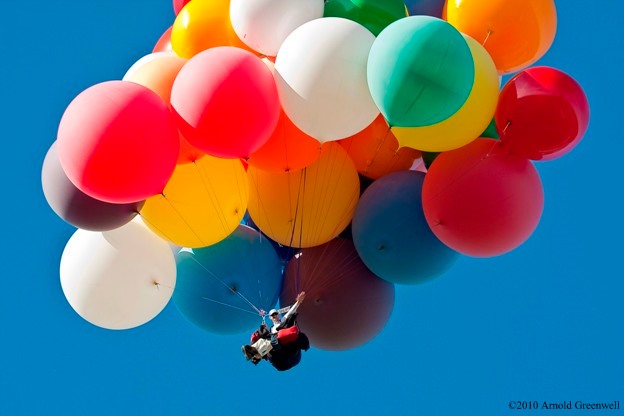
 The EAA and The Spirit of Aviation
The EAA and The Spirit of Aviation
Our friends at the EAA had sent out a team of specialists that are the best in the world at what they do. The team consists of an aviation photographer, and a photo-plane pilot. What they do is create amazing photographs. As you've seen, the name of the system we flew that day is The Spirit Cluster; it was named in honor of the EAA and it's motto, "The Spirit of Aviation." I am an EAA member, #879217, and I was tremendously proud to have friends from EAA1114 on the airfield, and friends from the national organization out to capture this flight. Thank you to the amazing team of EAA Chief Photographer Jim Koepnick and Photo 1 Pilot Bruce Moore, and to the Experimental Aircraft Association.
As I launched into the air, my crew chief and one crew member ran to the waiting Cessna 210. With Bruce Moore as the pilot, they gave chase through the skies.
There is a moment in the video I recorded in flight where I say "This is one of the greatest days." I meant that sincerely; when aloft, it means our planning and dreaming has come to fruition. This flight was months in the planning, and involved a great group of people. It was a pleasure and an honor to go aloft under this unlikely dream of balloons.
The chase aircraft spiraled up from the airfield to join me. I was in a steady ascent, and the chase plane climbed above the cluster to photograph the system with Raleigh Exec Airport as the backdrop.
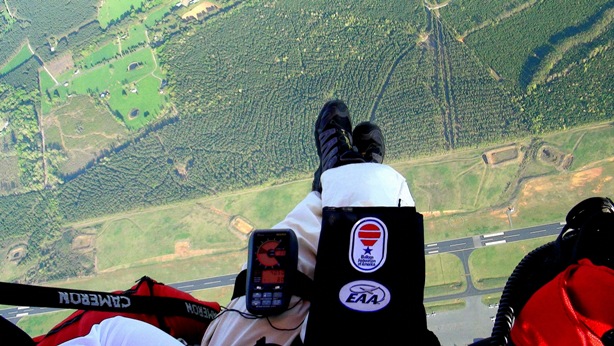 As I climbed through 4,050 feet, I took the opportunity to snap a photo showing my view.
As I climbed through 4,050 feet, I took the opportunity to snap a photo showing my view.
The next two hours of flight were ...awesome. The chase plane would make passes above, below, and on each side. Sometimes I could feel vibrations from its engine reverberate in my balloons. I climbed to about 7,500 feet, and then brought the system back towards earth.
Through the Late Evening - Floating
At launch, one little girl kept calling out to me: "Byee!..Byee!" In the video of launch, I'm several hundred feet in the air and I can still hear the girl calling out: "Byeeee!" As I climb through 590 feet, I can still hear her calling up to me.
In a separate video, taken from the ground, you can hear another little voice ask "...How will he get down?" What a great opportunity to sow dreams of flight. I know the children on the airfield will remember this flight; I know their parents will remember it as well. I do hope that the child's question was answered-- about how I would get down again-- and I do hope they will go aloft as pilots one day.
As the photo plane circled, climbed, banked, and flew around me, I ascended in silence. As I was approaching 3,000 feet, I could see the tiny planes on the airfield, still directly below me, as they taxied out for their flights. Being directly above an airport isn't actually the problem that some people envision. Unless they are launching helicopters or rockets, their aircraft don't climb straight up from the airfield! The approach and departure paths in front of the runways are the areas where communication and vigilance are paramount for us.
In the photo to the left, if you look carefully you will see that I have turned to my right and I'm working with something on my side. Those are the ballast bags; I'm dropping water to slow my descent. In these photos the water is falling in streams. As the water falls, it forms into an infinite number of tiny droplets that glitter in the fading sun as they rain slowly back to earth. Such a beautiful sight.
Into the Night
As the evening grew long, my chase plane made its final passes and the question came over the aircraft radio: "Are you going to land...or ...attempt to stay up through the night?" I had run that question through my mind a thousand times on this flight. I had personally sampled the winds up to 7,500 feet; I verified that the real-world conditions were in line with the forecasts. The trajectories indicated I should be able to stay clear of the coast, even staying aloft all night. Everything seemed to be lining up. I had dreamed of this. I reached into my flight bag, and I deployed the aviation lights that would accompany me into the darkness: hanging below me the steady white light, and the flashing red light, served to notify others that here flew a manned aircraft.
Fear - Genuine and non-trivial
 I'll tell you, I'm not sure if this is the right forum for this. I tend to be pretty upbeat in these flight reports. You can tell I love this beautiful form of flight, and this tiny sport of cluster ballooning.
I'll tell you, I'm not sure if this is the right forum for this. I tend to be pretty upbeat in these flight reports. You can tell I love this beautiful form of flight, and this tiny sport of cluster ballooning.
But, there is fear too. This is something I don't hear pilots talk about much. There is often bravado or swagger, as stories are told of the thunderstorms narrowly averted, or the close calls.
But, I don't hear pilots talk about fear. I had given this night flight some real thought. But, we hadn't done it. Nobody had. I've thought about it a lot, yet it was possible I was missing something. I'd done my homework; this was still unknown territory. When the night comes, the balloons cool. As that happens, they contract, and lift is lost. I argued that I should be able to offset the nighttime cooling by releasing ballast. Sure, any gas balloonist would tell you that. But, we didn't know how much ballast I would need to drop. And, if you don't have enough ballast to survive the night, it means attempting a nighttime landing, which is serious. I brought the ballast that I thought I would need. Even so, I entered the night with genuine trepidation.
I've worked on ways of handling the hot-fire type of fear, like panic or sudden terror. Mantras; breathing; task prioritization and focusing techniques. If you are putting yourself at 18,000 feet in a small harness, you had better have given some thought to these things in advance. You had better know how you will address these issues before you actually experience them in flight. If you are a pilot and don't have calming and focusing techniques that you have practiced using when calm, I argue that it is something you may like to investigate.
But, this was a different fear; it was a calculated concern, something I had given thought to. It was a cold apprehension. With this flight I was on the verge of proving myself correct, or incorrect. With all the talking I do about the beauty of cluster ballooning, I also understand that my life is at stake when I make these flights. Much more important than that is the safety of those I share the skies with, and those on the ground below. I take these things very seriously, and I entered the night with some concern.
Darkness falls (though, maybe I shouldn't use the word 'fall')
After I was committed to the night, my balloons floated over a marsh area; the waters were alive. Frogs called so clearly, and I could hear geese as they flew below me. I floated over this wide marsh area very peacefully. If I was in a hot-air balloon, I'd be rather worried about finding a place to land; you can't land in a swamp. Instead, in my helium balloons, I rode it out, knowing that I should be able to stay aloft for many hours, and this marsh would be long gone by then. As I climbed, the sounds of the marsh receded and I was left with silent flight; my immediate gondola became surrounded with complete darkness. There was no moon to accompany me into the night.
What I did have were the innumerable lights below me of the surrounding communities. I climbed up to 2,500 feet and started to layer on all of my cold weather gear: a base layer balaclava over my head, a pretty serious russian aviator hat, neck protection, gloves-- I put on everything, and it was not even 10:00pm; it would get much colder before the night was out.
Navigation, and RDU International Airport
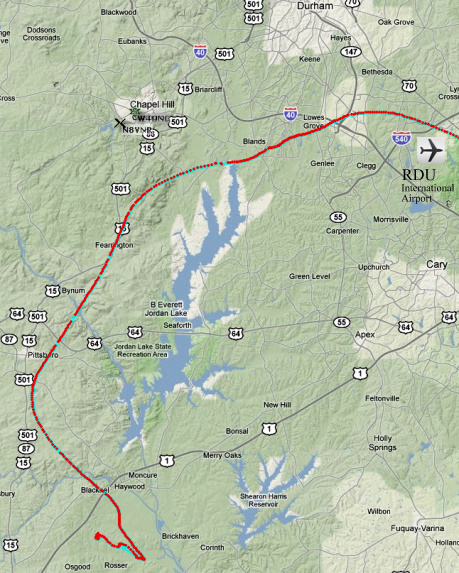 After nightfall, I maintained a comparatively low altitude-- around 2,500 feet. This had me going to the north east. That is good-- it is away from the restricted area, and away from the coast. I was tracking my position using my aviation sectional map and handheld gps, marking my location on the sectional as I floated to the north. Jordan Lake lay off to my right, an endlessly dark pool. In the night, the lake was very easy to identify; it was pitch black. Everywhere else there was a sprinkling of lights; Jordan Lake was a cold, endlessly dark pool.
After nightfall, I maintained a comparatively low altitude-- around 2,500 feet. This had me going to the north east. That is good-- it is away from the restricted area, and away from the coast. I was tracking my position using my aviation sectional map and handheld gps, marking my location on the sectional as I floated to the north. Jordan Lake lay off to my right, an endlessly dark pool. In the night, the lake was very easy to identify; it was pitch black. Everywhere else there was a sprinkling of lights; Jordan Lake was a cold, endlessly dark pool.
The outer ring of the RDU Class 'C' airspace extends about half-way across Jordan Lake; my track seemed like I might slip by that airspace...or I might clip it. My aircraft is invisible to radar; they can't get a primary radar signature off of my toy balloons. So, RDU wouldn't know I was there.
Near Fearington, I called up Raleigh Approach on the aircraft radio and identified myself and gave my location. The controller came back: "Eight Uniform Papa ....say again your aircraft type?" "I am a gas balloon, similar to a hot-air balloon, but filled with helium." The controller: "Uh, ok squawk 4096 and ident..." or whatever 4-digit code he read to me. That is, he wanted me to enter that code in my transponder, so that I would show up on radar; the transponder responds to radar interrogations with it's location and (if Mode C) it's altitude.
But, the code he gave me didn't matter; I didn't have a transponder.
I informed the approach controller of this, and he indicated that he would prefer I stay clear of the Class C airspace. I informed him that I could climb above it-- which would mean going to at least 4,500 feet-- up into the cold night. I need the permission of the controlling authority to overfly a Class C without a transponder. In this instance, RDU was the controlling authority and they gave permission-- as long as I remained clear of the actual Class C, an upside-down wedding-cake shaped 'bubble' extending around the airport.
 If I stayed at 2,500 feet, I might have slipped by the Class 'C' without entering it. However, by climbing, I caught winds out of the west-- which gave me a huge right-hand turn, and I my track changed-- to be straight towards the international airport.
If I stayed at 2,500 feet, I might have slipped by the Class 'C' without entering it. However, by climbing, I caught winds out of the west-- which gave me a huge right-hand turn, and I my track changed-- to be straight towards the international airport.
Click on the ATC image to the left to hear a condensed recording of some of the ATC interaction. The first thing you'll hear is the approach controller talking to a commercial jet, clearing them to land and telling the pilot that the balloon (me!) was off to his right or left. In fact, that 737 went directly underneath me; you'll hear me reply to the controller that "he's below me right now. Plenty of clearance, just letting you know where I am." My handheld aircraft radio was not picked up well by the tower that recorded the broadcast, you don't hear me much in the recordings, but you will hear the controllers.
I eventually transitioned from the Approach controller (who typically works in an enclosed room and handles arriving aircraft by managing them on a screen and the aircraft radio) to the Tower controller-- who is actually up in the tower with big windows and could attempt to get a visual on me.
As you will hear in the recordings, at first the tower can't see me very well: I am mixed in with the stars. I connect my aviation lights to a fresh battery, then I flash the tower with my spotlight. He sees the spotlight instantly; once the new battery is connected, he's got a visual on me.
It was awesome working with this controller. He invited me to stay on the Tower frequency as long as I wanted; he had no airplanes within 60 miles...no, actually, within 80 miles. Nobody within 80 miles of Raleigh airborne, but me. The recording you will hear is condensed from a couple of hours of floating through the quiet night above my city, working with our dedicated air traffic controllers.
HAMS - Amateur Radio Finds me in the Night
In addition to my aircraft radio, I carry a crew radio, to coordinate with my crew back on the surface. Some enterprising HAM radio operators were following my APRS track, and decided to try to track me down in the skies. My crew radio has a 'privacy code' (PL / CTCSS tone) programmed, so even if they found my frequency, I wouldn't hear them. Well, being the enterprising amateur radio HAMS that they are, they just tried all the privacy codes! There are about...52 of them.
My radio woke up and I heard their voices. I was very surprised to hear them calling me; it was awesome, actually. The night had grown very cold a mile up in the air, and I was very happy to hear their voices break the quiet. They let me know that they were tracking my flight, and that it was being covered on WRAL, the local CBS affiliate. I spoke with several different individuals, and it was a welcome addition to the flight.
One of the HAMS happened to be an experienced commercial pilot, a 737 captain. Before I reached RDU airport, he telephoned the tower and briefed them on my flight, pointing the controller to our website and tracking information. It was this 737 captain that suggested I flash the tower with my spotlight, so they could get a fix on me. It worked! Thanks to that airline pilot, the tower also had my tracking information from this website and could track me. This interaction with the HAM community was a welcome surprise, and the help of that 737 captain added a substantial safety factor by giving the tower an idea of what kind of aircraft I was, plus the tracking info. Thank you!
Last words into the Night - Raleigh Tower fades into the distance
As 2:00am approached, my time flying over my home city was drawing to an end. I had past the lights of our downtown and was heading back to the still of the countryside. The aircraft radio had been quiet for some time, and I got these final calls as I drifted out of the airports range. The tower controller called me, and I could hear him on the aircraft radio. "You still out there in the balloon, south east of Raleigh?" I could hear him, and I responded. But, I was out of range; he couldn't hear my reply.
 He called again, asking if I could hear his transmission. When he didn't hear my reply, he requested that I flash the tower with my spotlight. I took the spotlight out from its bag, and looked back towards the airport. The city was receding into an indistinguishable sea of lights. I could no longer tell where the airport was; all of the individual lights blended into a single stream of light. I flashed the entire horizon behind me, back and forth. At a distance of over 20 miles, he saw the light, and acknowledged the flash over the radio.
He called again, asking if I could hear his transmission. When he didn't hear my reply, he requested that I flash the tower with my spotlight. I took the spotlight out from its bag, and looked back towards the airport. The city was receding into an indistinguishable sea of lights. I could no longer tell where the airport was; all of the individual lights blended into a single stream of light. I flashed the entire horizon behind me, back and forth. At a distance of over 20 miles, he saw the light, and acknowledged the flash over the radio.
Click the image to the right to hear the final exchange that night. This would be the last communication I would have with anyone for the following five hours as I left the lights, and left my city, behind. I moved into dark, open countryside as the temperature continued to drop in the silence of the night.
Dead of Night
After the last call from the tower controller, I departed from all direct connections to everything and everyone below me. I had blown out my crew radio talking with the HAMs; it had no more battery. The aircraft radio still had charge, but I couldn't raise the crew on it.
The temperature continued to drop as I went deeper into the night. On the surface it was in the 40's; it was below freezing aloft. My aircraft was still high, due to the climb I initiated hours ago, to climb over the Class C. That was way back in Raleigh-- before Raleigh, actually. I didn't want to release helium to come down (into warmer temperatures) because it would mean using a flight resource. I only have so much ballast to last the night; I only have so much helium in my balloons. I did not want to use up my resources, and use up my options.
Instead I opted to let the system descend with the continued temperature decline. But the decent rate was glacial; in an hour I had descended from 4,700 feet 4,400 feet. That's roughly 5 feet per minute, a rate so close to level that it doesn't even show up on the rate of climb indicator.
I again tried the crew on the radio; I talked into the air. Nobody down there.
There were various arrays of towers, far below me, far off to the side. I'm out into open countryside, pointed back towards the ocean. By 3:00am, 4:00am, I had...bad thoughts. Not dreams-- I wasn't sleeping, trust me. But the thoughts were like...dreams. Thoughts that came without me calling them. They didn't really make sense, but I worried about my rigging. I'm connected to the system only by two 1-inch straps; the idea is that I can cut those two pieces of nylon very easily, and be free of the system if I need to be. (If, for example, I'm on the ground and dragging towards an obstruction, like power lines.) But, I became distrustful of those 1-inch slivers of material. I kept thinking I would have to hold on, wrap my arms around my ballast bags and try to hold on. I kept banishing those thoughts.
Language is important. You will notice that I said 'kept banishing' the thoughts. That means they kept coming back, and had to be quieted again.
Extending my track out in front of me on the aviation map I could see Emerald Isle, Atlantic Beach, North Topsail Beach; you can tell by the place names that the coast is coming. It is 4:00am, 5:00am. Those last ribbons of sand are still distant, out in front of me; 40 miles, perhaps. And my speed is low. The sun should come before I reach them.
Waiting for the Sun
I longed for the return of the sun. I wanted the warmth to come again. I wanted to brush treetops with my feet, as you can in a balloon. I wanted to know that my crew, who had been awake all night, were OK. I'm sure they wanted to know I was ok. I longed for the return of the sun.
And, as it does, the sun returned. There were rumors of light, in the beginning. And a trick the moon played, by coming above the horizon perhaps an hour before dawn. It was a beautiful sliver of a moon, and it pulled up Venus directly underneath it as she climbed. Tricks of the moon, and rumors of light on the horizon.
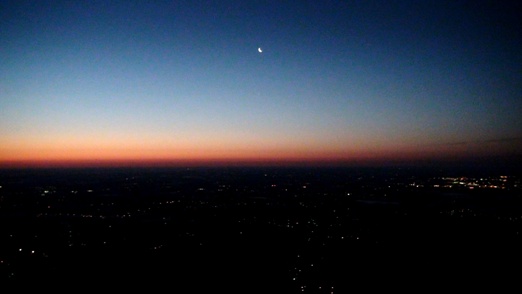 Then, rumors turned to promises, and promises delivered light to the sky. Still the sun hadn't come, but as the horizon faintly started to light, my descent rate increased. Temperature regularly continues to drop until *after* dawn. It doesn't warm when the sun first crests; it has to be up for a little while, to warm the air.
Then, rumors turned to promises, and promises delivered light to the sky. Still the sun hadn't come, but as the horizon faintly started to light, my descent rate increased. Temperature regularly continues to drop until *after* dawn. It doesn't warm when the sun first crests; it has to be up for a little while, to warm the air.
I pulled a balloon to me, and opened a cell. Cold gas came streaming out. "Test Test Test?" I pronounced out loud, testing the pitch of my voice. I wanted to make sure I was getting some air as well, and not breathing pure helium. All was fine; my hands eventually tired of holding the balloon, and she escaped to the skies. That is fine, good in fact. It increased my descent back to the earth.
At this point, it was unclear to me which was my home: the earth or the sky.
Returning to touch the earth:
I came lower, lower. Then, large fields underneath me. I could take these fields. Direction made a sharp turn; not quite a u-turn, but a substantial change in direction at the surface. Speed actually picked up-- 18, 19 knots. Then, through a clearing in the trees I could see a vehicle, with a hint of something behind it. It could be...could be my car, my crew, my girlfriend, with our tiny trailer behind. I flew an approach profile, coming very low-- tree level. The sun is now up. Oops, a little too low-- the trees could brush me, or brush my balloons. If the trees touch my balloons, they could pop, and this would all end very ungracefully. One cell would pop, making me heavier, pushing more balloons into the trees, making more balloons pop-- a cascading effect would end with me hanging from the trees, or plunging down through them.
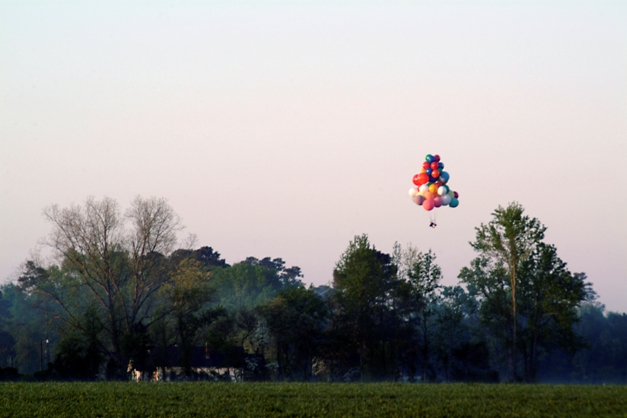 Ballast-- one more ballast-- to bring me just above tree level. I make it to that road--- and it was my crew! They are there! They were there all night! The sun has returned, the earth is near me, my crew is at hand as I crest the treeline-- with a small corner of a field in front of me. It is time; I choose this time to again touch the earth.
Ballast-- one more ballast-- to bring me just above tree level. I make it to that road--- and it was my crew! They are there! They were there all night! The sun has returned, the earth is near me, my crew is at hand as I crest the treeline-- with a small corner of a field in front of me. It is time; I choose this time to again touch the earth.
One balloon is away, descent rate is taking me into my field, crew is out of the vehicle coming across the ground to me as I approach earth. I ballast as I'm coming down, so that I won't return to earth with too hard of a jolt. 10 feet above the ground I close the ballast tank; the earth greets me gently, and I'm down.
Nearly 14 hours in the sky, and I'm down. We survived the night, flew over my city, my state, with my girlfriend and crew with me throughout the night.
How tremendous.
Jonathan R. Trappe,
Cluster Balloonist
With Great Appreciation:
My heartfelt thanks go to:
- The Experimental Aircraft Association (EAA) - For welcoming our unusual aircraft into the skies, and helping with aircraft certification via the homebuilders group - The Spirit Cluster Soared! The Spirit of Aviation is Alive!
- Sport Aviation Magazine - Mary Jones, Adam Smith, and everyone at the organization for support of this flight, including the June 2010 issue of Sport Aviation Magazine;
- The Wings of Carolina Flying Club - For having us out at the club to talk about ballooning, and then for all the help standing and launching the aircraft;
- Members of EAA1114 - For hosting us at Cox Field to talk about Cluster Ballooning, and for standing the cluster balloon aircraft on the day of our flight;
- Kent Misegades - For connecting our unique form of flight with our larger EAA organization;
- The Raleigh Executive Airport @ Lee County - For hosting us on the airfield;
- Dan Swanson - Airport Manager at TTA - For having us at the Family Fun Day, and for pre-and-post support of this flight;
- Controllers at Raleigh-Durham International Airport - For guiding our quiet craft through your skies while maintaining safe separation from other aircraft, and for helping guide our flight safely thorough the night;
- The World-Class team of Jim Koepnick and Bruce Moore - Photographer and Photo-plane team Extraordinaire! What awesome photos! What awesome fun in the air!
- Brian Hoyle - For the test-run flight under hot-air the weekend before the Spirit Cluster!
- Amateur Radio HAMs - For seeking me out in the skies for airborne radio camaraderie; a special shout-out to the 737 pilot that helped me coordinate with the RDU tower, including the suggestion to flash them with the spotlight; your contribution added tremendously to the flight;
- Tom Tomasetti - For the loan of the aviation lights and spotlight-- couldn't have made it through the night without them!
- Robin Person, Brad Bradshaw, Gene Hunter, Matt Snyder, and friends for all the help going into the skies!
- Dave Palmer and Trish - For outstanding graphics, standing the balloon, and for chasing us down at the dawn;
- Everyone that came out to the airfield to inflate the balloons, stand the aircraft, and wish us well as we slipped into the skies!
- Special thank you to Anne Honeycut for setting up the field, standing the aircraft, and chasing throughout the night;
- Endless thank you to Nidia Ruiz Ramirez
Cluster Ballooning: National Public Radio
The Story, With Dick Gordon - Full Interview .mp3 interview Here
The Spirit Cluster:
Magazines:
 |
|||
|---|---|---|---|
| Aerostat - UK |
Selected Additional Accounts:
CBS: Aired May 3rd, 2010) |
|---|
Track-over-the-ground: 109 miles